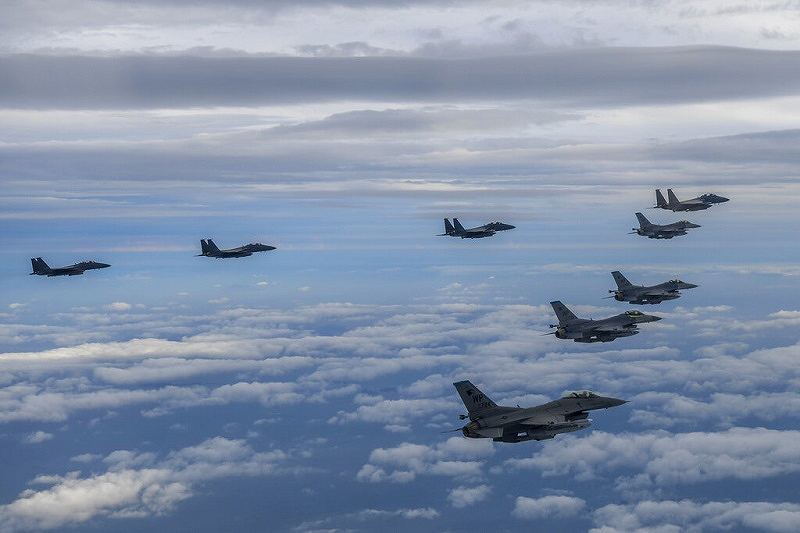After North Korea missile launch, U.S. and South Korea hold precision bombing drill to show counter-attack ability

South Korean Air Force’s F-15K fighter jets and U.S. Air Force’s F-16 fighter jets, fly in formation during a joint drill in an undisclosed location in South Korea on Tuesday.
17:31 JST, October 5, 2022
SEOUL / WASHINGTON —The United States and South Korea have been on heightened alert over North Korea’s efforts to improve its ballistic missile capabilities. Both countries intend to further strengthen their deterrence capabilities against North Korea, including the U.S. “nuclear umbrella.”
According to South Korea’s Joint Chiefs of Staff, the U.S. and South Korean militaries held a joint exercise Tuesday in the Yellow Sea, west of the Korean Peninsula, in which a combined total of eight South Korean Air Force F-15s and U.S. Air Force F-16 fighter aircraft took part in a drill of precisely bombing hypothetical targets with guided bombs.
This was carried out in response to North Korea’s launch of an intermediate-range ballistic missile earlier in the day. It was aimed at demonstrating, in the event of a contingency, their ability to accurately strike a missile-launch site before North Korea launches a missile, and to retaliate against such an act.
U.S. Secretary of State Antony Blinken and South Korean Foreign Minister Park Jin also talked over the phone and agreed to maintain the defense posture of the U.S.-South Korea alliance and to further strengthen trilateral cooperation among the United States, South Korea, and Japan. Since the launch of a ballistic missile runs counter to U.N. Security Council resolutions, the two ministers also discussed how to respond to the missile launch at the U.N. Security Council.
At a standing committee meeting of South Korea’s National Security Council (NSC) held on Tuesday morning, President Yoon Suk-yeol condemned North Korea, saying, “North Korea’s nuclear and missile provocations will only invite further strengthening of security cooperation among South Korea, the United States, Japan and other countries.” Since the May inauguration of Yoon’s administration, which advocates a shift from the conciliatory line toward North Korea pursued by his predecessor, the U.S. and South Korea have adopted a policy of seeking North Korea’s denuclearization by putting their military capabilities at the forefront.
Washington and Seoul have reiterated their policy of South Korea being provided with “extended deterrence,” in which the U.S. considers an attack on its ally an attack on itself and responds accordingly, even through the use of nuclear force. The two countries believe that overwhelming deterrence is necessary to prevent North Korea from escalating its military provocations, as it advances in the sophistication of its nuclear and missile technologies.
In August, the United States and South Korea conducted joint exercises, including field maneuver drills, for the first time in about four years. And in September they held joint naval drills, for the first time in about five years, in the waters near South Korea, with a U.S. nuclear aircraft carrier participating. In addition to strengthening the U.S.-South Korea alliance, South Korea is also hurrying to develop its own defense system and plans to increase its related budget.
While strengthening defense readiness, the United States and South Korea are also calling for dialogue with North Korea toward its denuclearization.
The U.S. administration of President Joe Biden has taken a “calibrated, practical approach” to North Korea and has stated that if North Korea moves ahead with denuclearization in stages, it will respond by easing sanctions accordingly. This is a departure from the approach taken by former President Donald Trump, who attempted to achieve the complete denuclearization of North Korea and the complete lifting of sanctions through direct dialogue between the leaders of the two countries.
The Yoon administration has also announced that it will follow the U.S. lead and provide economic assistance in line with gradual denuclearization.
"Politics" POPULAR ARTICLE
-

Japan to Support Central Asian Logistics Route That Bypasses Russia, Plan to Be Part of Upcoming Summit in Tokyo
-

Japan to Tighten Screening of Foreigners’ Residential Status by Providing Information of Nonpayment of Taxes
-

Takaichi Cabinet Approval Holds at 72% as Voters Back Aggressive Fiscal Stimulus, Child Benefits
-

Chinese, Russian Bombers Flew Unusual Path by Heading Toward Tokyo; Move Likely Meant to Intimidate Japan
-

Takaichi Meets Many World Leaders at G20 Debut in Johannesburg; Speaks with Heads of Countries Including Italy, U.K., Germany, India
JN ACCESS RANKING
-

Keidanren Chairman Yoshinobu Tsutsui Visits Kashiwazaki-Kariwa Nuclear Power Plant; Inspects New Emergency Safety System
-

Imports of Rare Earths from China Facing Delays, May Be Caused by Deterioration of Japan-China Relations
-

Tokyo Economic Security Forum to Hold Inaugural Meeting Amid Tense Global Environment
-

University of Tokyo Professor Discusses Japanese Economic Security in Interview Ahead of Forum
-

Japan Pulls out of Vietnam Nuclear Project, Complicating Hanoi’s Power Plans

























